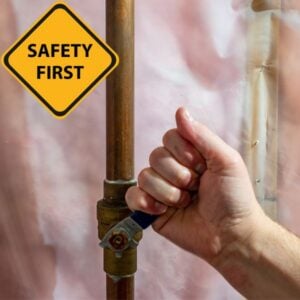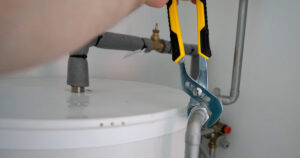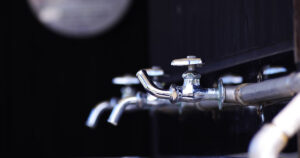Don’t Forget This Important Task Before Leaving Town: Turn Your Water Shut Off Valve

Leaving town can be exciting, but it’s often accompanied by a long list of responsibilities that can add to the stress. In addition to packing, arranging for pet sitters, and pausing your mail service, there’s one crucial yet simple task many homeowners overlook: turning your water shut off valve.
This simple step can save you from coming back to a plumbing disaster.
The Risks of a Water Leak While You’re Away
Water leaks are never convenient, but when they happen while you’re away, they can be especially destructive. Your home’s water supply is under constant pressure, meaning that even a small, unnoticed leak can cause significant damage in just a few hours. Left unchecked for days, that damage can multiply exponentially, leading to costly repairs.
When you’re home, you can catch leaks early. But when you’re away, you risk returning to find floors, walls, or even entire rooms ruined by water damage. Turning off your water supply before you leave town is an easy and effective way to avoid this scenario.
Sophisticated Water Shut-Off Solutions
For those who want extra peace of mind, smart water shut-off devices are a great option. One example is the Moen Flo, a smart system that can detect leaks and automatically shut off your water to prevent further damage. These devices are ideal for homeowners who travel often or want added security. Many insurance companies even offer discounts for installing these systems because they know how quickly water damage can escalate.
A smart shut-off system continuously monitors water usage, identifying any irregularities. Whether it’s a minor drip or a major burst, these systems can act instantly, even sending notifications to your phone. It’s a sophisticated solution for modern homeowners who want to prevent water damage before it happens.
The Free and Easy Alternative: Use Your Main Water Shut Off Valve
If you’re looking for a free and simple alternative, manually turning off your home’s water supply is a great option. By shutting off the water and draining your pipes, you relieve the pressure on your system and eliminate the risk of leaks while you’re away.
Here’s how to do it:
Step-by-Step Guide to Turning Off Your Water
For those unfamiliar with the process, here’s a step-by-step guide:
- Find your main shut-off valve. It’s typically located near where your main water line enters your home. This could be in your basement, utility room, or garage. If you’re struggling to locate it, a plumber can help you find it. The plumber can also confirm whether the valve is in good working order.
- Turn off the valve. Most modern homes have a ball valve that is easy to turn. Simply rotate the valve clockwise to shut off the water supply.
- Drain your pipes. Open a few faucets to release any water still sitting in your pipes. This will remove the pressure and ensure no water can leak.
- Check that the water is off. Try turning on faucets around your home to ensure no water comes out. This confirms the water is shut off completely.
An Important Caution: Be Aware of Your Shut-Off Valve Type
Not all shut-off valves are the same. If your home is older, you may have a problematic main shut off valve. Take a look ahead of time so that you aren’t learning about the different types of shut off valves during an emergency.
Gate Valves
A gate valve is a type of valve used to control the flow of water in plumbing systems by lifting or lowering a metal gate inside the valve body. It works by rotating a round handle, often wheel-shaped, which raises the gate to allow water flow or lowers it to block it. Gate valves can often be identified by their tall, rectangular shape, and the need to turn the handle multiple times to fully open or close the valve.
These valves are more common in older homes but can become problematic over time, as they tend to get stuck after years of use, either in the open or closed position. While a stuck open valve is inconvenient, a stuck closed valve can be a bigger problem, preventing you from restoring water when you return home. In an emergency, a gate valve that is stuck open can also be a major problem. With a gate valve stuck open, you won’t be able to stop a bad leak from turning into a flood.
Ball Valves
Newer systems usually replace gate valves with ball valves, which are easier to operate and more reliable. A ball valve is a type of shut-off valve that controls water flow using a rotating ball with a hole through its center. When the valve handle is turned 90 degrees, the ball rotates, aligning the hole with the water pipe to allow flow, or blocking it to stop the flow. Ball valves are easily identified by their lever handle, which turns in one swift motion—parallel to the pipe when open and perpendicular when closed. They are highly reliable, providing a quick, full shut-off with minimal effort.
The main shut-off valve is one of the most important components of your plumbing system. It’s your first line of defense against leaks and burst pipes. If it’s old or unreliable, you could be facing a serious issue when you need it most. Proactively replacing it can save you a lot of stress and expense in the long run.
Know Where Your Main Shut-Off Valve Is
Every homeowner should know where their main water shut-off valve is located. It’s a critical part of homeownership that can save you from major water damage. Typically, the valve is found where the main water line enters the home, which could be in your basement, garage, or utility room. If you’re unsure of its location, or if you can’t find it, it’s important to have a plumber help you locate and inspect it.
At Aaron Services, we offer a Plumbing Comfort Club Membership, which includes locating your visible shut-off valves and making sure they’re in good working order. Having this peace of mind means you won’t be scrambling to find the valve during an emergency.
What to Expect When You Turn Your Water Back On
When you return home, turning the water back on is as simple as reversing the steps you took to shut it off. However, don’t be alarmed if you notice some sputtering or unexpected noises from your faucets. This is just air being pushed out of your pipes as water flows back in. It’s completely normal and should clear up after a few minutes of running the water.
Here’s what to do:
- Turn the main valve counterclockwise to restore the water supply.
- Open faucets slowly to let the air escape. You might hear a bit of sputtering or notice bursts of water, but this is just the air being forced out.
- Check your fixtures. Run water from several faucets to ensure everything is back to normal.
The next time you leave town, you can do so with peace of mind brought to you by Aaron Services: Plumbing, Heating, Cooling. And don’t worry! If you’re not sure where your main shut off valve is, or if you have an older gate valve that you don’t trust, give us a call. We’re happy to help you with any plumbing or HVAC issue, and love to educate our customers.






